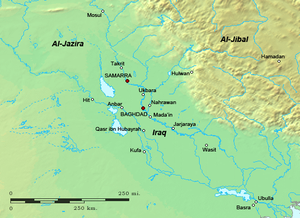Sabuktakin
Sabuktakin was a Turkic slave who was set free by the first Buyid ruler of Iraq, Mu'izz al-Dawla (r. 945–967), and became, according to the historian Heribert Busse, the latter's "right-hand man".
[7] At the time of his death, he is reported to have possessed 10,000 camels and 4,000 brocade garments, including 2,000 of fine shushari silk and 500 prized pieces from the state factories of the Byzantine Empire.
[10] The Turks had provided the core of the Iraqi military since Abbasid times, but the Buyids were brought to power by their Daylamite soldiery, and both groups competed for privileges and income.
[12] As part of the efforts to strike a balance between the two groups, Mu'izz al-Dawla in his testament explicitly recommended to Bakhtiyar to retain Sabuktakin in office.
[13] In 974, Bakhtiyar and Sabuktakin campaigned north in an attempt to take advantage of recent Byzantine advances in Upper Mesopotamia to finally subdue the Hamdanid ruler of Mosul, Abu Taghlib.
In the meantime, Bakhtiyar was left with little military strength in Mosul; the contemporary historian Miskawayh assumed that Sabuktakin deliberately delayed coming to his aid, and that he was conspiring with the Hamdanids to depose the Buyids.
[13][15] In the meantime, Sabuktakin was able to use the widespread calls for jihad among the populace for his own ends, by diverting the mob's ire to the Shi'a Buyids and their supporters.
[16] These events made the breach between Sabuktakin and his ostensible master inevitable: following the advice of Ibn Baqiyya, Bakhtiyar left Baghdad for Wasit and Ahwaz.
[13] Finally, in July 974, the two rival parties clashed openly: Sabuktakin took control of Baghdad, and after a brief siege of their palace expelled the Buyid family members and the Daylamite soldiers from the city.
